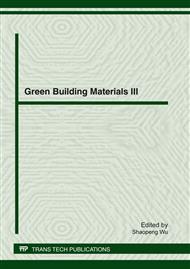p.1
p.6
p.13
p.20
p.26
p.33
p.40
p.45
Combined Effect of Mineral Admixture and Curing Condition on Pore Structure of Concrete
Abstract:
The effect of mineral admixture and curing condition in pore structure of concrete was studied in this paper. Concrete samples with different component were prepared firstly, and then they were put into standard condition, fresh water and salt environment that produced artificially respectively at 20 °C. After the experiments of curing at 3, 28 and 180 days pore structure were tested by mercury intrusion porosimetry (MIP). The results obtained reveal that with the increase of the age, the pore structure degradation impact in salt environment of concrete increase dramatically. When at 28 days, total pore volume and porosity of concretes in fresh water is lower by 20% and 5% respectively than the ones with larger mean pore size and critical aperture in salt environment, which represents pore refinement in fresh water had a good effect. Compared to the salt environment erosion, it can be found that the impact of pore refinement in fresh water is more significant.
Info:
Periodical:
Pages:
6-12
Citation:
Online since:
April 2012
Authors:
Keywords:
Price:
Сopyright:
© 2012 Trans Tech Publications Ltd. All Rights Reserved
Share:
Citation:


